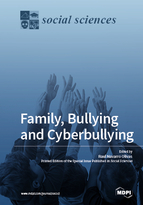Family, Bullying and Cyberbullying
A special issue of Social Sciences (ISSN 2076-0760).
Deadline for manuscript submissions: closed (31 December 2018) | Viewed by 97865
Special Issue Editor
Interests: interpersonal violence; bullying; cyberbullying; gender-based violence; LGTBI+ studies
Special Issues, Collections and Topics in MDPI journals
Special Issue Information
Dear Colleagues,
Despite the significant decrease in bullying that has been reported in many countries during the last two decades, bullying continues to be a significant problem among young people. Given the increase of Internet use among youth, researchers started to pay attention to cyberspace, understanding that it may be a fertile ground for bullying behaviors, specifically what is known as cyberbullying. The connection between these two types of bullying is not surprising if we bear in mind that cyberspace may function as an extension of the school context, and it is also consistent with the idea that, although online interaction differs to face-to-face interaction, they both shape an overlapping social space to communicate with friends or schoolmates.
Research around the world has shown that traditional bullying is linked to family characteristics, such as poor parent-children relationships, lack of parental emotional support, infrequent and poor parental monitoring, sibling warmth and family cohesion. Research on family and cyberbullying is still limited, but available studies have shown similar results to those reported in traditional bullying. However, inquiry is still warrants to know how multiples variables related to the family context influence on bullying and cyberbullying behaviors. This Special Issue will bring together current papers that advance knowledge about the association of family variables and bullying and cyberbullying. These variables may include family cohesion, communication, and mediation, parenting behaviors, sibling relationships, and personal characteristics of parents that can contribute as protective or risk factors in bullying and cyberbullying among children, adolescents or young adults. We would like encourage submissions describing research involving a wide range of family and youth variables. All kinds of papers are invited: Conceptual, methodological, narrative reviews, systematic reviews, experimental research, findings based on survey data and qualitative studies. Cross-cultural comparative papers are particularly welcomed, and studies with youth from a variety of backgrounds in terms of socio-economic status, gender, ethnicity, and other family conditions.
Dr. Raul Navarro Olivas
Guest Editor
Manuscript Submission Information
Manuscripts should be submitted online at www.mdpi.com by registering and logging in to this website. Once you are registered, click here to go to the submission form. Manuscripts can be submitted until the deadline. All papers will be peer-reviewed. Accepted papers will be published continuously in the journal (as soon as accepted) and will be listed together on the special issue website. Research articles, review articles as well as short communications are invited. For planned papers, a title and short abstract (about 100 words) can be sent to the Editorial Office for announcement on this website.
Submitted manuscripts should not have been published previously, nor be under consideration for publication elsewhere (except conference proceedings papers). All manuscripts are thoroughly refereed through a double-blind peer-review process. A guide for authors and other relevant information for submission of manuscripts is available on the Instructions for Authors page. Social Sciences is an international peer-reviewed open access monthly journal published by MDPI.
Please visit the Instructions for Authors page before submitting a manuscript. Submitted papers should be well formatted and use good English. Authors may use MDPI's English editing service prior to publication or during author revisions.
Keywords
- Bullying
- Cyberbullying
- Family
- Siblings
- Parental mediation
- Parental communication
- Family socialization
- Family cohesion
- Gender
- Cross-cultural studies






